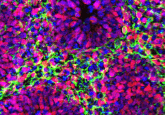T-VEC: what’s next for oncolytic virotherapy and immuno-oncology?

In this interview we speak with Kevin Harrington (The Institute of Cancer Research, London, UK) about his pioneering work in the development of T-VEC, the first oncolytic virotherapy that was approved by the US FDA. We also discuss the CheckMate141 trial and his upcoming work on improving outcomes for patients in whom combination treatments do not work the first time round.
What would you say has your greatest career achievement so far?
If I was looking back on a completed career at some point in the future, I guess one of the things that would give me the greatest sense of pride would be the fact that I had an involvement in the development and approval of the first oncolytic virotherapy that was approved by the FDA, subsequently by the EMA and then by other regulatory authorities around the world – T-VEC. We were involved in its development from the Phase I clinical trial and I was the UK principal investigator for the Phase II and the Phase III clinical trials and the data that accrued from that has subsequently led to the approval of this drug at a global level.
Could you tell us more about the mechanism of action of T-VEC and details of the trials you mentioned?
T-VEC is a genetically modified herpes simplex virus type I, so the cold sore virus. The virus has been modified in a number of key ways which makes it a very elegant therapeutic. The first thing that was done was a new strain of the virus was isolated from an individual who had recurrent cold sores and this virus was quite a lytic virulent virus.
In the laboratory the virus was genetically manipulated to remove both copies of the viral gene ICP 34.5, which is the viral gene that is associated with so called neurovirulence that allows the virus to establish infections in nerve cells and potentially contributes to latency. Those genes were removed and one of the byproducts of removing them was to make the virus selectively replication competent in cancer cells with many orders of magnitude of difference between cancer and normal cells, in terms of its ability to kill.
That space within the virus was replaced with two genetic cassettes, both have the same sequence and express the human granulocyte macrophage colony stimulating from a strong viral promoter, a CMV promoter leading to high levels of expression of GM-CSF, a potent immune active cytokine in infected cells.
The other modification of the virus was to remove the gene ICP47. This is the viral gene that allows it to mask itself from the immune system by shutting off the antigen presentation machinery within infected cells. So taking that gene out meant that the virus was now visible in infected cells and, therefore, could act potentially as a strong immune adjuvant. Another byproduct of removal of the ICP47 gene is that the virus replicates a little more strongly than viruses that do not have ICP47 deleted. So this is really a beautifully engineered product. It was taken through clinical trials, initially Phase I showing safety and defining a regimen that was possible to deliver in the clinic involving, first, a relatively low dose of the virus as the first injection at 1 x 106 plaque-forming units per milliliter of injection up to 4 mL of injection, and then subsequent injections at 1 x 108 plaque-forming units/mL up to a maximum of 4 mL of injection. This was then taken all the way through Phase II studies where activity was confirmed in melanoma and then into the pivotal Phase III clinical trial.
The OPTiM trial involved a total of 436 patients with melanoma randomly assigned to either T-VEC or the control arm of subcutaneous GM-CSF treatment; the randomization was done in a 2:1 fashion. Patients receiving T-VEC demonstrated a significant improvement in response rate and in durable response rate. That latter measure was a primary endpoint of the study. Overall survival for the intention to treat population narrowly failed to achieve statistical significance but in subgroup analysis of patients with relatively earlier stage disease as stage IIIB, stage IIIC and stage IV M1a disease and patients at an earlier phase of treatment, especially those being treated in the first line setting, we demonstrated an improvement in overall survival. So those data in totality, were used as part of the submission to the FDA and then subsequently to other regulators, which led to the approval of T-VEC at a global level.
Earlier this year, you published an update on the CheckMate 141 trial. Could give us a bit more information about that trial?
The CheckMate 141 study again is an extremely important clinical trial from the point of view of how to manage patients with head and neck cancer. Patients who had received platinum-based chemotherapy and had progressed within less than 6 months of the therapy were eligible for treatment. Patients were randomized either to nivolumab at a dose of 3 mg/kg or standard of care systemic chemotherapy and that was with was one of three drugs: single-agent docetaxel, single-agent methotrexate or single agent cetuximab (an anti-EGFR drug). The total number of patients in the study was 361, with 240 receiving nivolumab and 121 receiving one of the standard of care agents.
The data were analyzed for both overall survival and progression-free survival, and the remarkable finding was for the first time in a so-called second line population of patients (patients with platinum-refractory disease) we saw an improvement in overall survival. This was significant with a hazard ratio in the initial analysis around 0.70, so a 30% reduction in the relative risk of death from the disease. It was subsequently shown that at the 12-month landmark analysis, the number of patients alive who were receiving nivolumab was approximately twice as many as the number of patients receiving standard of care chemotherapy, and the subsequent 2-year analysis that were published in 2018 showed that those data were maintained, although that difference had narrowed a little. It was not quite double the difference but it was approximately 33% versus 19% for the nivolumab versus standard of care treatment of the 12-month landmark analysis.
There was no difference in progression-free survival, the median progression-free survivals were equivalent between the two groups of patients, but there were marked differences in overall survival. We also published data in Lancet Oncology in 2017 dealing with the patient-reported outcome measures and quality of life measures demonstrating, broadly speaking, that patients receiving nivolumab maintained quality of life or patient reported outcome measures score relative to the chemotherapy. These data have been instrumental in the approval of nivolumab as a therapy for use in the US, also in Europe and in the UK and elsewhere in the world for patients with head and neck cancer. Certainly from the point of view of my role as a UK oncologist, I am particularly happy that this drug is available to patients in the UK through the Cancer Drug Fund as regulated by the National Institute for Health and Care Excellence (NICE).
Going on from that, what are your next plans in terms of your research and also further investigations?
The big areas now, of unmet need, are in moving these therapies forward from patients with relapsed or metastatic disease to using them at earlier time point in the patient’s journey. We are already beginning to see the first outputs of the so-called first line studies in relapsed/metastatic disease of patients in whom these drugs, these immunotherapies, are being randomized either as single agents or in combination against standard of care platinum-based chemotherapy in head and neck cancer. I think we will see data in the coming months reporting on those outcomes, there has been a press release about the KEYNOTE-048 study demonstrating a significant benefit from pembrolizumab relative to combination chemotherapy, and we await full presentation of those data at the ESMO meeting in October 2018. Otherwise, I think the real direction of travel is to incorporate immune checkpoint inhibition into regimens where patients are receiving either curative surgery or curative radiation and chemotherapy with a view to trying to cure more patients at the first time of presentation; to prevent the need for treating them in the setting of relapsed/metastatic disease. There is huge clinical trial activity around this area and that will be read out in the next 3–5 years, I think we will see some very interesting data.
Then the next major focus for me, of course, is what happens for patients in whom those treatments do not work the first time round, the immuno-oncology drug refractory or resistant population. I think there are huge opportunities to use other drugs that can effectively fine tune the immune response, so including direct injection of drugs that will interact with the innate immune system and that includes virus therapies like T-VEC, viruses like Reovirus, Coxsackievirus, vaccinia virus, all of which we are working on in the laboratory and in the clini. There are also opportunities with other activators of innate immunity including drugs like STING agonists which, I think, are very exciting drugs and may have a role to play in a diverse range of tumors including head and neck cancers. So there is plenty to keep us busy for the next 5–10 years.
Profile: Kevin Harrington BSc(Hons), MBBS(Hons), MRCP, FRCR, FRCP, DIC, PhD is Joint Leader of the Division of Radiotherapy and Imaging at The Institute of Cancer Research/Royal Marsden Hospital and Biomedical Research Centre Theme Lead for research in Targeted Physical Therapies. He leads a team of 15 researchers in the Targeted Therapy Team in the Division of Radiotherapy and Imaging. He is also an Honorary Consultant Clinical Oncologist at The Royal Marsden NHS Foundation Trust.
Prof. Harrington completed postdoctoral research in Professor Richard Vile’s laboratory in the Molecular Medicine Program at the Mayo Clinic, Minnesota before joining the ICR in 2001 as leader of the Targeted Therapy Team.
Prof. Harrington specializes in developing new treatments with a specific focus on head and neck cancer and melanoma. His twin research interests are in oncolytic virotherapy/immunotherapy and in targeted radiation sensitizers. He is a Fellow of the Royal College of Physicians and a Fellow of the Royal College of Radiologists. He has published more than 470 peer-reviewed papers and 45 book chapters and has edited 3 books.





